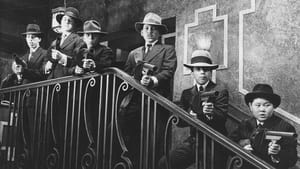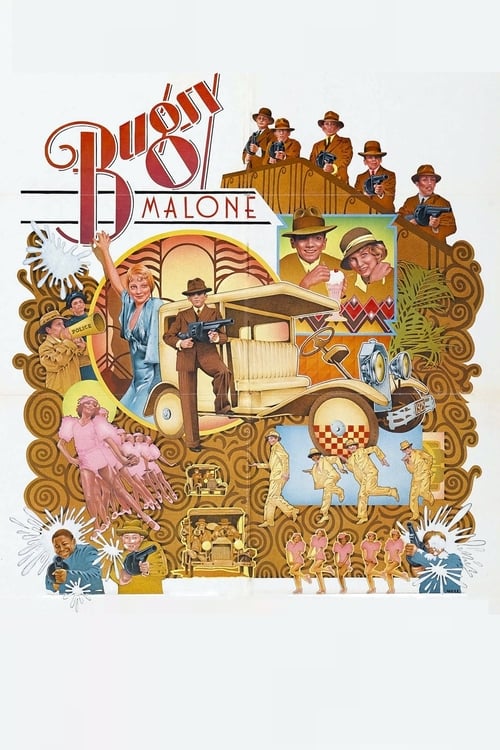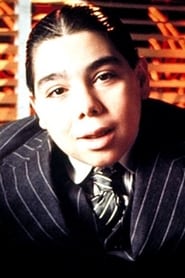Cast
View AllScott Baio
as Bugsy Malone
Jodie Foster
as Tallulah
Florrie Dugger
as Blousey
John Cassisi
as Fat Sam
Martin Lev
as Dandy Dan
Paul Murphy
as Leroy Smith
Sheridan Earl Russell
as Knuckles
Albin 'Humpty' Jenkins
as Fizzy
Paul Chirelstein
as Smolsky
Andrew Paul
as O'Dreary
Davidson Knight
as Cagey Joe
Michael Jackson
as Razamataz
Jeff Stevenson
as Louis
Peter Holder
as Ritzy
Donald Waugh
as Snake Eyes
Crew
Director
- Alan Parker
Writer
- Alan Parker
Producer
- Alan Marshall
Reviews
CinemaSerf
There is something cartoon-like about this gangster spoof. The characters are all played by children and instead of spraying their rivals with bullets, they find themselves being creamed to death. The plot centres around the turf wars between "Dandy Dan" (Martin Lev) and "Fat Sam" (John Cassisi) and the shrewd manoeuvrings of the eponymous character (Scott Baio). Add to the mix the seductive, sultry, "Tallulah" (Jodie Foster) and you have the makings of a gently comedic production. There's quite a decent list of songs to keep it moving - "Bugsy Malone", "Down and Out" and "So You Wanna be a Boxer". Not songs you might recognise by their titles, but ones your toes start instinctively tapping to when the ensemble break into their well choreographed delivery. It's an OK watch, this, but I found that the initially innovative joke wore a bit thin quite quickly and the scenarios prove just a little too repetitive. That said, Foster and Baio work quite well together and it does look good - sending up all things Al Capone! Worth a watch, but nothing great.
Jul 26, 2023
Thematic Analysis
As a dramatic work, Bugsy Malone examines complex human relationships and emotional struggles against the backdrop of a period setting that reflects societal issues of its time. The character development particularly stands out, offering viewers a chance to reflect on their own life journeys.
Director Alan Parker brings their distinctive visual style to this film, continuing their exploration of themes seen in their previous works while adding new elements. Their approach to character development and emotional depth creates a viewing experience that rewards close attention.
Released in 1976, the film exists within a cultural context that now offers viewers historical perspective on the social issues of that era. Its reception demonstrates the diverse reactions to its artistic choices and its place in cinema history.
Did You Know?
- The production of Bugsy Malone took approximately 32 months from pre-production to final cut.
- The final cut of the film runs for 93 minutes, though the director's initial assembly was reportedly 149 minutes long.
- The director insisted on using practical effects whenever possible, reserving CGI for only the most necessary scenes.
- The screenplay went through 6 major revisions before the final shooting script was approved.
- The costume department created over 451 unique costume pieces for the production.
Historical Context
- In 1976, when this film was released:
- Environmental awareness was growing as a social concern.
- The Watergate scandal changed public perception of political institutions.
- The film industry was dominated by major studios, with independent cinema still in its early development.
How This Film Stands Out
While Bugsy Malone shares thematic elements with other films in its genre, it distinguishes itself through its unique approach to storytelling, visual style, and character development.
Unlike One to One: John & Yoko, which focuses more on action than character development, Bugsy Malone subverts genre expectations by exploring its themes with greater nuance.
While films like The Shadow Strays and Out of My Comfort Zone explore similar territory, Bugsy Malone stands apart through its deeper exploration of its central themes and more complex characterization.
This film's unique contribution to cinema lies in its thoughtful balance of entertainment value and thematic depth, making it a valuable addition to its genre.
Details
- Release Date: July 22, 1976
- Runtime: 1h 33m















